A Comprehensive Report on Heat Stress Risk Assessment in the Workplace
VerifiedAdded on 2020/03/02
|12
|2168
|498
Report
AI Summary
This report provides a detailed risk assessment of heat stress in the workplace, focusing on environmental hazards and toxicity. It begins with an introduction to the increasing global temperatures and the associated risks for workers, particularly those in open and unshaded environments. The report then defines heat stress, its causes, and the body's mechanisms for dealing with it, including sweat evaporation. It outlines the risks associated with heat stress, such as heat cramps, heat stroke, and heat exhaustion, including symptoms and treatments. The report delves into the Workplace Safety and Health (WSH) Act, highlighting the company's responsibility to minimize heat stress risks. It specifies risk assessment measures related to heat stress, open working conditions, and workload, in accordance with WSH guidelines. The report recommends preventive actions, including providing protective gear, arranging temporary shelters, adjusting work schedules, and ensuring adequate hydration and access to medical facilities. It also includes budget requests for necessary equipment and services. Finally, the report provides evaluation measures to ensure worker safety and concludes with references to relevant WSH guidelines and publications.
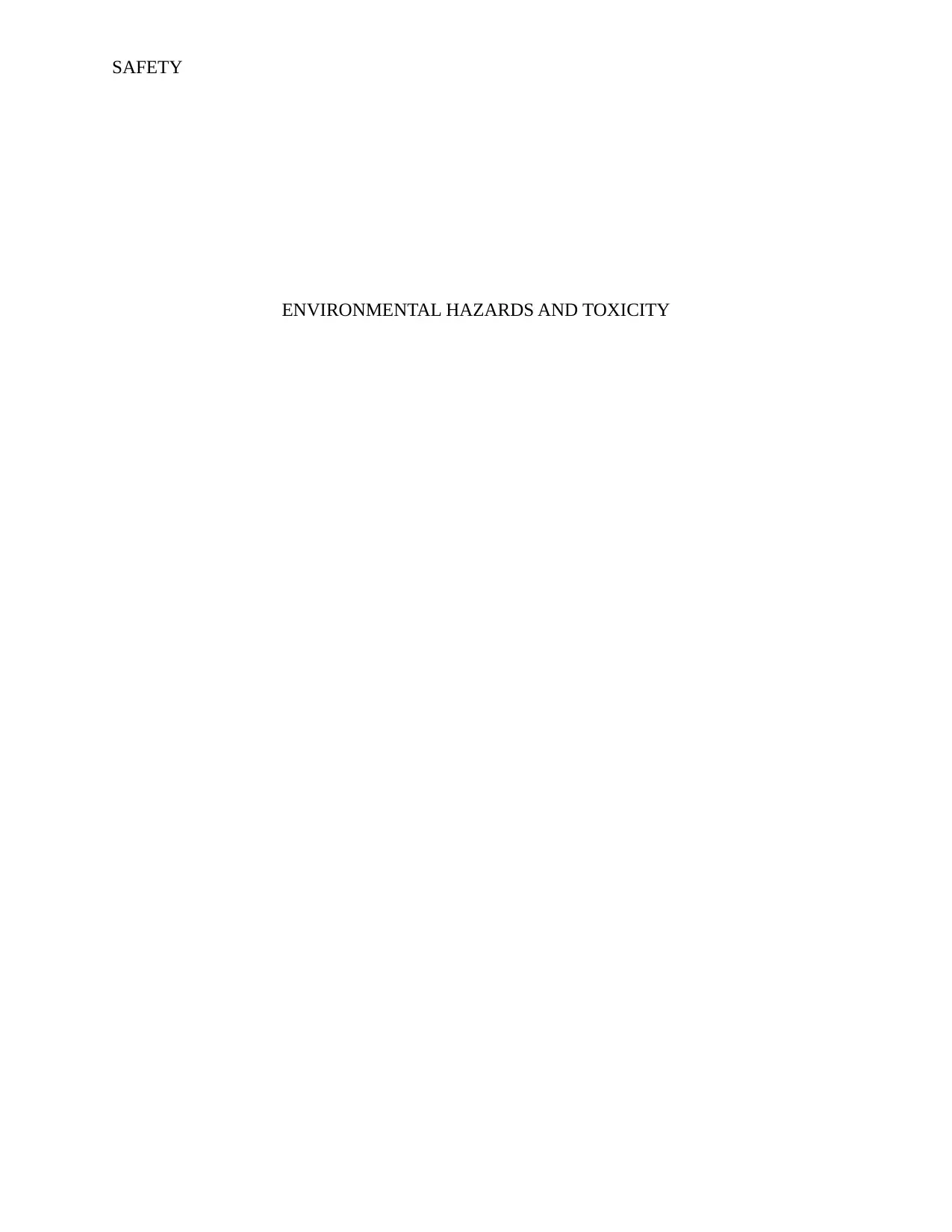
SAFETY
ENVIRONMENTAL HAZARDS AND TOXICITY
ENVIRONMENTAL HAZARDS AND TOXICITY
Paraphrase This Document
Need a fresh take? Get an instant paraphrase of this document with our AI Paraphraser
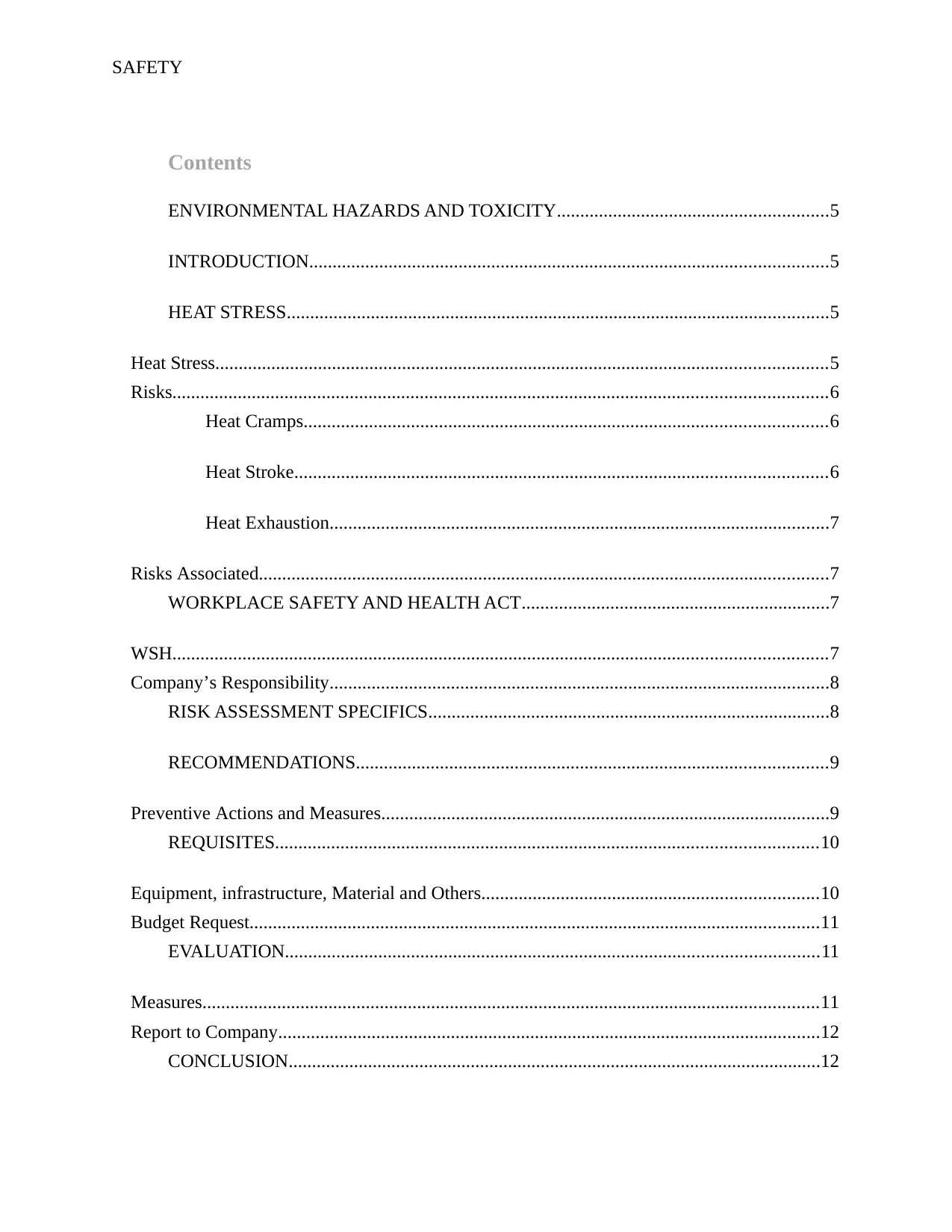
SAFETY
Contents
ENVIRONMENTAL HAZARDS AND TOXICITY..........................................................5
INTRODUCTION...............................................................................................................5
HEAT STRESS....................................................................................................................5
Heat Stress...................................................................................................................................5
Risks............................................................................................................................................6
Heat Cramps................................................................................................................6
Heat Stroke..................................................................................................................6
Heat Exhaustion...........................................................................................................7
Risks Associated..........................................................................................................................7
WORKPLACE SAFETY AND HEALTH ACT..................................................................7
WSH............................................................................................................................................7
Company’s Responsibility...........................................................................................................8
RISK ASSESSMENT SPECIFICS......................................................................................8
RECOMMENDATIONS.....................................................................................................9
Preventive Actions and Measures................................................................................................9
REQUISITES....................................................................................................................10
Equipment, infrastructure, Material and Others........................................................................10
Budget Request..........................................................................................................................11
EVALUATION..................................................................................................................11
Measures....................................................................................................................................11
Report to Company....................................................................................................................12
CONCLUSION..................................................................................................................12
Contents
ENVIRONMENTAL HAZARDS AND TOXICITY..........................................................5
INTRODUCTION...............................................................................................................5
HEAT STRESS....................................................................................................................5
Heat Stress...................................................................................................................................5
Risks............................................................................................................................................6
Heat Cramps................................................................................................................6
Heat Stroke..................................................................................................................6
Heat Exhaustion...........................................................................................................7
Risks Associated..........................................................................................................................7
WORKPLACE SAFETY AND HEALTH ACT..................................................................7
WSH............................................................................................................................................7
Company’s Responsibility...........................................................................................................8
RISK ASSESSMENT SPECIFICS......................................................................................8
RECOMMENDATIONS.....................................................................................................9
Preventive Actions and Measures................................................................................................9
REQUISITES....................................................................................................................10
Equipment, infrastructure, Material and Others........................................................................10
Budget Request..........................................................................................................................11
EVALUATION..................................................................................................................11
Measures....................................................................................................................................11
Report to Company....................................................................................................................12
CONCLUSION..................................................................................................................12

SAFETY
REFERENCES..................................................................................................................12
REFERENCES..................................................................................................................12
⊘ This is a preview!⊘
Do you want full access?
Subscribe today to unlock all pages.

Trusted by 1+ million students worldwide
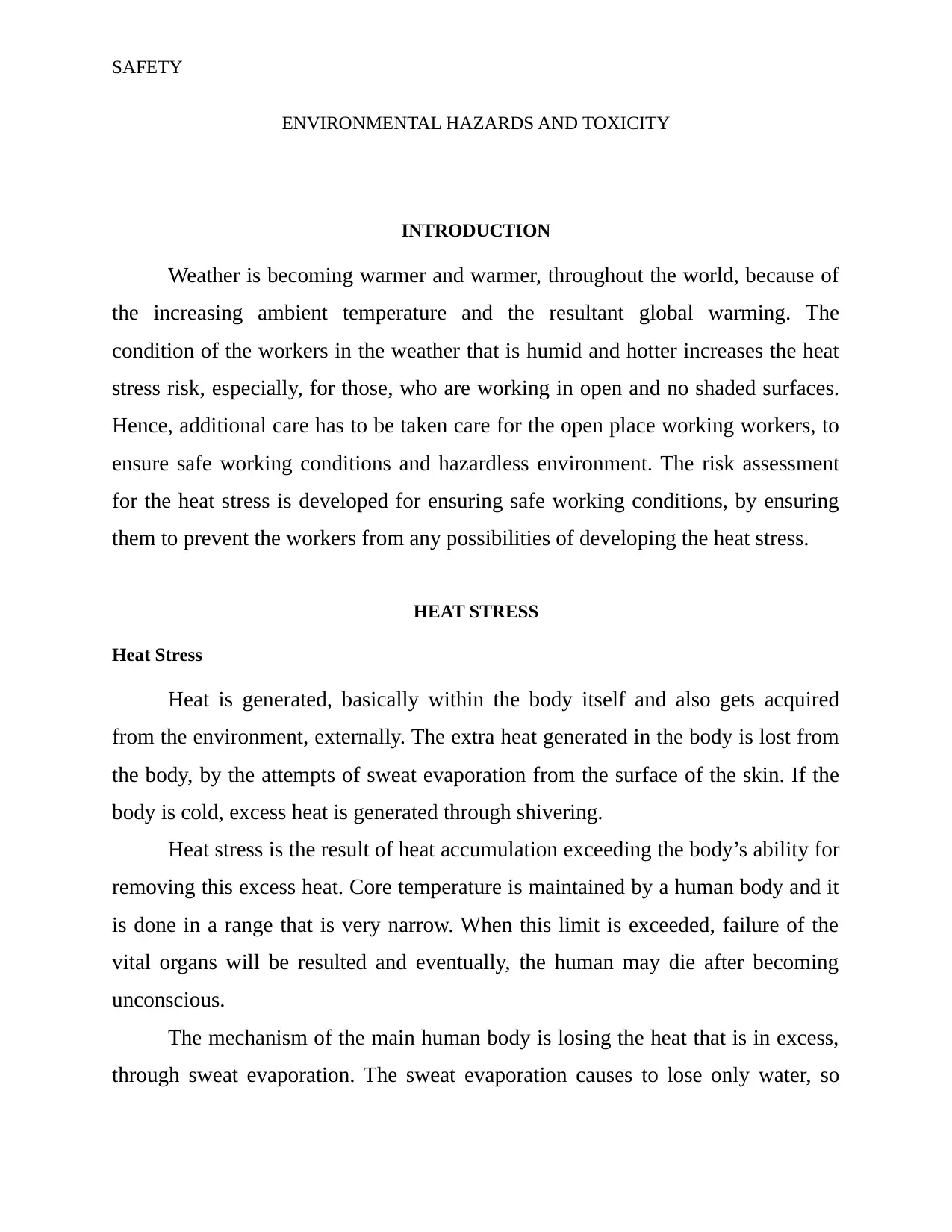
SAFETY
ENVIRONMENTAL HAZARDS AND TOXICITY
INTRODUCTION
Weather is becoming warmer and warmer, throughout the world, because of
the increasing ambient temperature and the resultant global warming. The
condition of the workers in the weather that is humid and hotter increases the heat
stress risk, especially, for those, who are working in open and no shaded surfaces.
Hence, additional care has to be taken care for the open place working workers, to
ensure safe working conditions and hazardless environment. The risk assessment
for the heat stress is developed for ensuring safe working conditions, by ensuring
them to prevent the workers from any possibilities of developing the heat stress.
HEAT STRESS
Heat Stress
Heat is generated, basically within the body itself and also gets acquired
from the environment, externally. The extra heat generated in the body is lost from
the body, by the attempts of sweat evaporation from the surface of the skin. If the
body is cold, excess heat is generated through shivering.
Heat stress is the result of heat accumulation exceeding the body’s ability for
removing this excess heat. Core temperature is maintained by a human body and it
is done in a range that is very narrow. When this limit is exceeded, failure of the
vital organs will be resulted and eventually, the human may die after becoming
unconscious.
The mechanism of the main human body is losing the heat that is in excess,
through sweat evaporation. The sweat evaporation causes to lose only water, so
ENVIRONMENTAL HAZARDS AND TOXICITY
INTRODUCTION
Weather is becoming warmer and warmer, throughout the world, because of
the increasing ambient temperature and the resultant global warming. The
condition of the workers in the weather that is humid and hotter increases the heat
stress risk, especially, for those, who are working in open and no shaded surfaces.
Hence, additional care has to be taken care for the open place working workers, to
ensure safe working conditions and hazardless environment. The risk assessment
for the heat stress is developed for ensuring safe working conditions, by ensuring
them to prevent the workers from any possibilities of developing the heat stress.
HEAT STRESS
Heat Stress
Heat is generated, basically within the body itself and also gets acquired
from the environment, externally. The extra heat generated in the body is lost from
the body, by the attempts of sweat evaporation from the surface of the skin. If the
body is cold, excess heat is generated through shivering.
Heat stress is the result of heat accumulation exceeding the body’s ability for
removing this excess heat. Core temperature is maintained by a human body and it
is done in a range that is very narrow. When this limit is exceeded, failure of the
vital organs will be resulted and eventually, the human may die after becoming
unconscious.
The mechanism of the main human body is losing the heat that is in excess,
through sweat evaporation. The sweat evaporation causes to lose only water, so
Paraphrase This Document
Need a fresh take? Get an instant paraphrase of this document with our AI Paraphraser
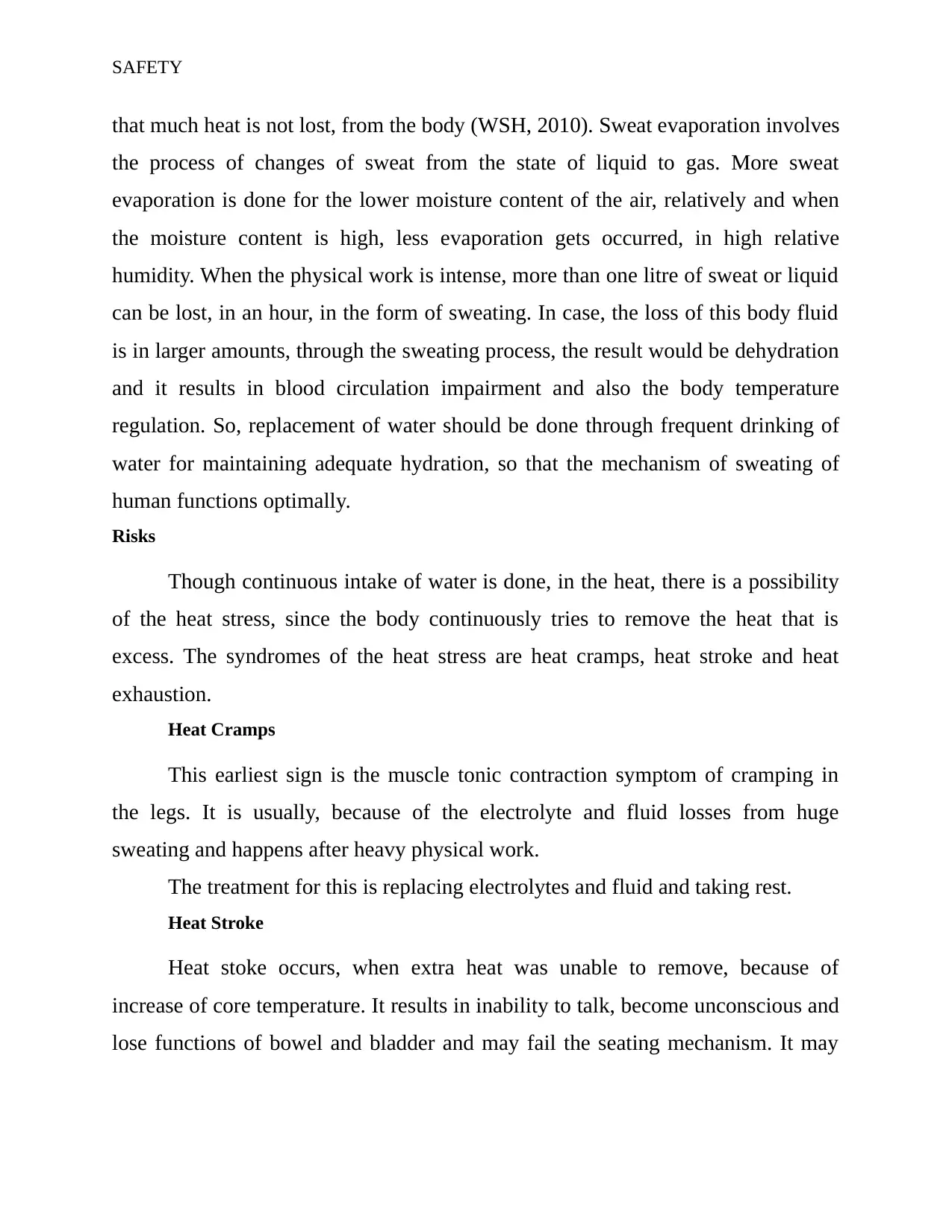
SAFETY
that much heat is not lost, from the body (WSH, 2010). Sweat evaporation involves
the process of changes of sweat from the state of liquid to gas. More sweat
evaporation is done for the lower moisture content of the air, relatively and when
the moisture content is high, less evaporation gets occurred, in high relative
humidity. When the physical work is intense, more than one litre of sweat or liquid
can be lost, in an hour, in the form of sweating. In case, the loss of this body fluid
is in larger amounts, through the sweating process, the result would be dehydration
and it results in blood circulation impairment and also the body temperature
regulation. So, replacement of water should be done through frequent drinking of
water for maintaining adequate hydration, so that the mechanism of sweating of
human functions optimally.
Risks
Though continuous intake of water is done, in the heat, there is a possibility
of the heat stress, since the body continuously tries to remove the heat that is
excess. The syndromes of the heat stress are heat cramps, heat stroke and heat
exhaustion.
Heat Cramps
This earliest sign is the muscle tonic contraction symptom of cramping in
the legs. It is usually, because of the electrolyte and fluid losses from huge
sweating and happens after heavy physical work.
The treatment for this is replacing electrolytes and fluid and taking rest.
Heat Stroke
Heat stoke occurs, when extra heat was unable to remove, because of
increase of core temperature. It results in inability to talk, become unconscious and
lose functions of bowel and bladder and may fail the seating mechanism. It may
that much heat is not lost, from the body (WSH, 2010). Sweat evaporation involves
the process of changes of sweat from the state of liquid to gas. More sweat
evaporation is done for the lower moisture content of the air, relatively and when
the moisture content is high, less evaporation gets occurred, in high relative
humidity. When the physical work is intense, more than one litre of sweat or liquid
can be lost, in an hour, in the form of sweating. In case, the loss of this body fluid
is in larger amounts, through the sweating process, the result would be dehydration
and it results in blood circulation impairment and also the body temperature
regulation. So, replacement of water should be done through frequent drinking of
water for maintaining adequate hydration, so that the mechanism of sweating of
human functions optimally.
Risks
Though continuous intake of water is done, in the heat, there is a possibility
of the heat stress, since the body continuously tries to remove the heat that is
excess. The syndromes of the heat stress are heat cramps, heat stroke and heat
exhaustion.
Heat Cramps
This earliest sign is the muscle tonic contraction symptom of cramping in
the legs. It is usually, because of the electrolyte and fluid losses from huge
sweating and happens after heavy physical work.
The treatment for this is replacing electrolytes and fluid and taking rest.
Heat Stroke
Heat stoke occurs, when extra heat was unable to remove, because of
increase of core temperature. It results in inability to talk, become unconscious and
lose functions of bowel and bladder and may fail the seating mechanism. It may
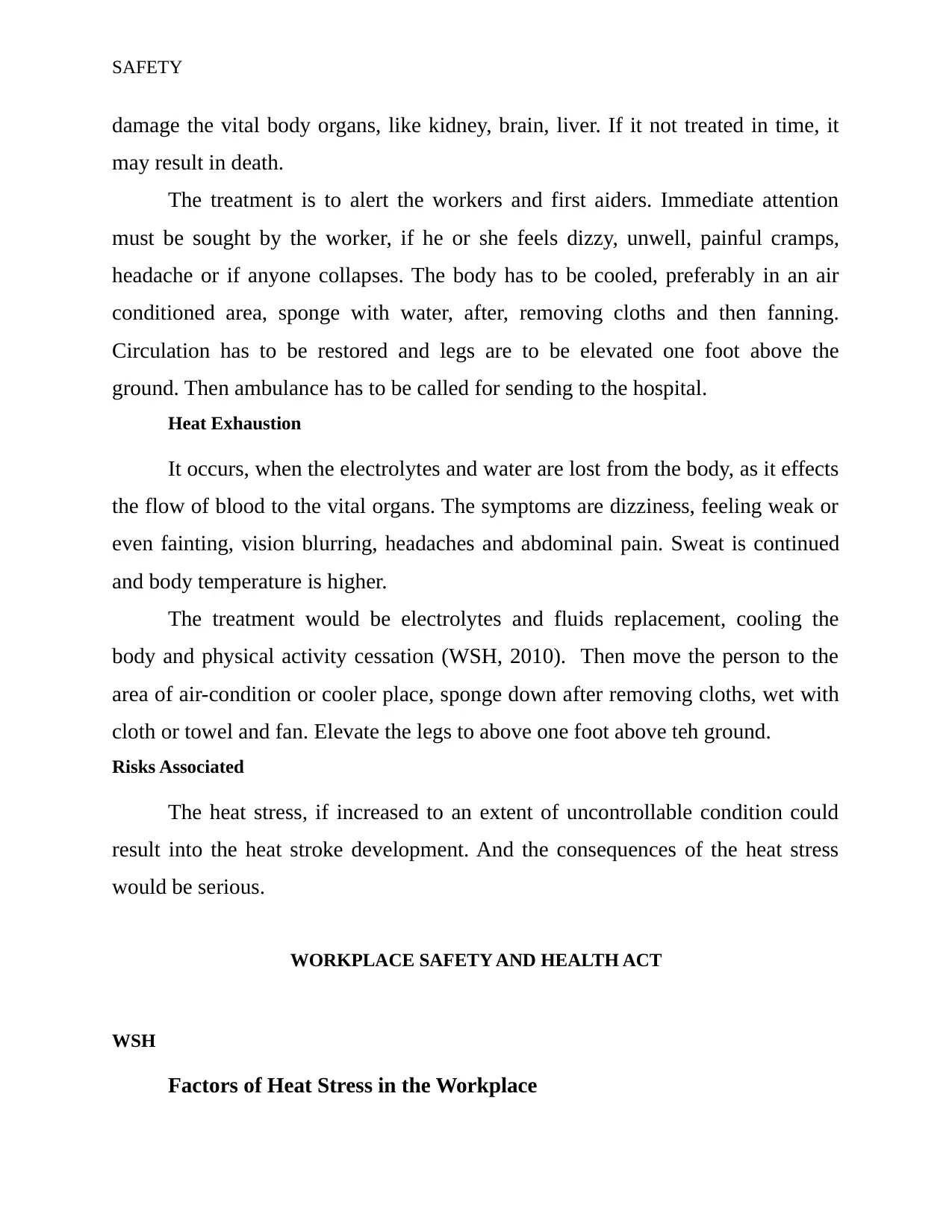
SAFETY
damage the vital body organs, like kidney, brain, liver. If it not treated in time, it
may result in death.
The treatment is to alert the workers and first aiders. Immediate attention
must be sought by the worker, if he or she feels dizzy, unwell, painful cramps,
headache or if anyone collapses. The body has to be cooled, preferably in an air
conditioned area, sponge with water, after, removing cloths and then fanning.
Circulation has to be restored and legs are to be elevated one foot above the
ground. Then ambulance has to be called for sending to the hospital.
Heat Exhaustion
It occurs, when the electrolytes and water are lost from the body, as it effects
the flow of blood to the vital organs. The symptoms are dizziness, feeling weak or
even fainting, vision blurring, headaches and abdominal pain. Sweat is continued
and body temperature is higher.
The treatment would be electrolytes and fluids replacement, cooling the
body and physical activity cessation (WSH, 2010). Then move the person to the
area of air-condition or cooler place, sponge down after removing cloths, wet with
cloth or towel and fan. Elevate the legs to above one foot above teh ground.
Risks Associated
The heat stress, if increased to an extent of uncontrollable condition could
result into the heat stroke development. And the consequences of the heat stress
would be serious.
WORKPLACE SAFETY AND HEALTH ACT
WSH
Factors of Heat Stress in the Workplace
damage the vital body organs, like kidney, brain, liver. If it not treated in time, it
may result in death.
The treatment is to alert the workers and first aiders. Immediate attention
must be sought by the worker, if he or she feels dizzy, unwell, painful cramps,
headache or if anyone collapses. The body has to be cooled, preferably in an air
conditioned area, sponge with water, after, removing cloths and then fanning.
Circulation has to be restored and legs are to be elevated one foot above the
ground. Then ambulance has to be called for sending to the hospital.
Heat Exhaustion
It occurs, when the electrolytes and water are lost from the body, as it effects
the flow of blood to the vital organs. The symptoms are dizziness, feeling weak or
even fainting, vision blurring, headaches and abdominal pain. Sweat is continued
and body temperature is higher.
The treatment would be electrolytes and fluids replacement, cooling the
body and physical activity cessation (WSH, 2010). Then move the person to the
area of air-condition or cooler place, sponge down after removing cloths, wet with
cloth or towel and fan. Elevate the legs to above one foot above teh ground.
Risks Associated
The heat stress, if increased to an extent of uncontrollable condition could
result into the heat stroke development. And the consequences of the heat stress
would be serious.
WORKPLACE SAFETY AND HEALTH ACT
WSH
Factors of Heat Stress in the Workplace
⊘ This is a preview!⊘
Do you want full access?
Subscribe today to unlock all pages.

Trusted by 1+ million students worldwide
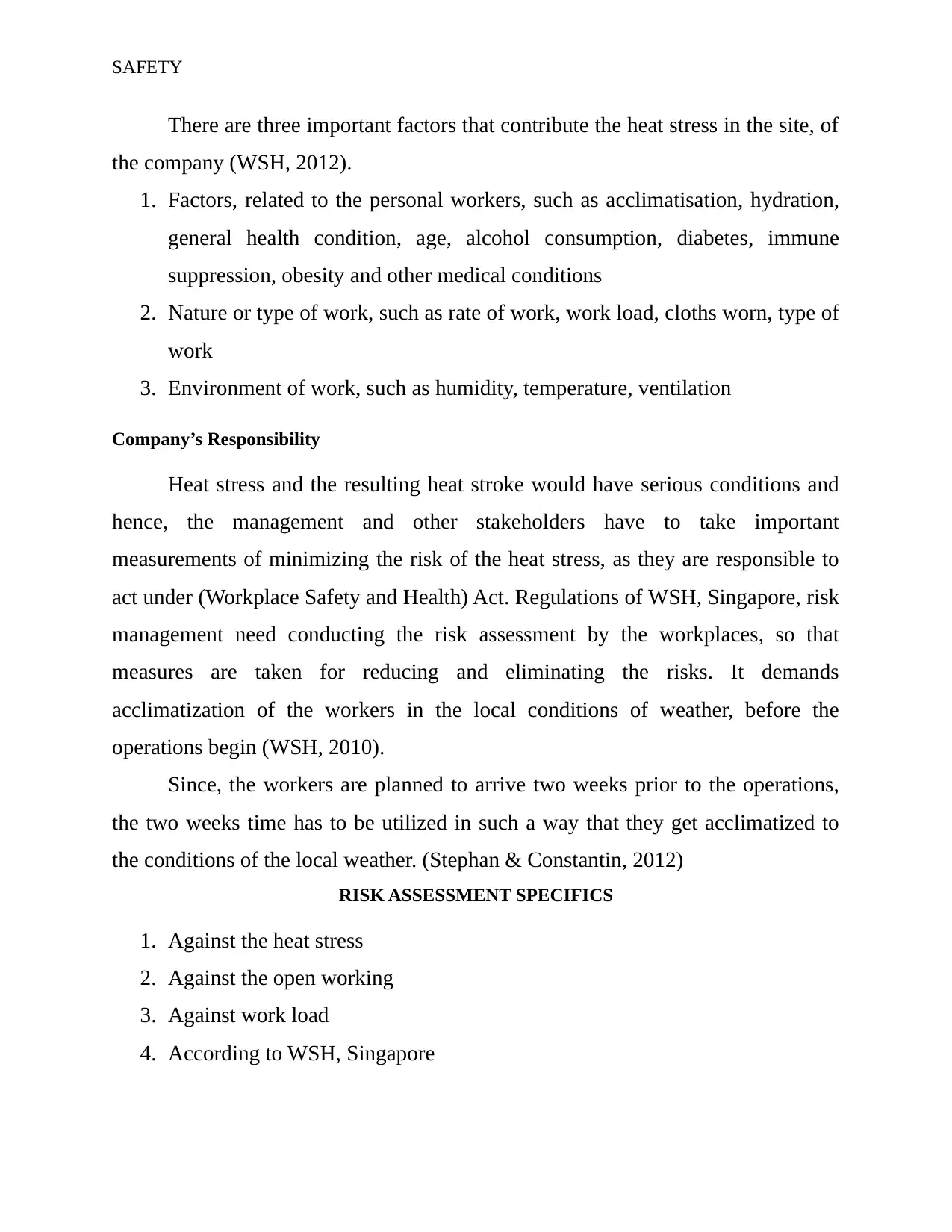
SAFETY
There are three important factors that contribute the heat stress in the site, of
the company (WSH, 2012).
1. Factors, related to the personal workers, such as acclimatisation, hydration,
general health condition, age, alcohol consumption, diabetes, immune
suppression, obesity and other medical conditions
2. Nature or type of work, such as rate of work, work load, cloths worn, type of
work
3. Environment of work, such as humidity, temperature, ventilation
Company’s Responsibility
Heat stress and the resulting heat stroke would have serious conditions and
hence, the management and other stakeholders have to take important
measurements of minimizing the risk of the heat stress, as they are responsible to
act under (Workplace Safety and Health) Act. Regulations of WSH, Singapore, risk
management need conducting the risk assessment by the workplaces, so that
measures are taken for reducing and eliminating the risks. It demands
acclimatization of the workers in the local conditions of weather, before the
operations begin (WSH, 2010).
Since, the workers are planned to arrive two weeks prior to the operations,
the two weeks time has to be utilized in such a way that they get acclimatized to
the conditions of the local weather. (Stephan & Constantin, 2012)
RISK ASSESSMENT SPECIFICS
1. Against the heat stress
2. Against the open working
3. Against work load
4. According to WSH, Singapore
There are three important factors that contribute the heat stress in the site, of
the company (WSH, 2012).
1. Factors, related to the personal workers, such as acclimatisation, hydration,
general health condition, age, alcohol consumption, diabetes, immune
suppression, obesity and other medical conditions
2. Nature or type of work, such as rate of work, work load, cloths worn, type of
work
3. Environment of work, such as humidity, temperature, ventilation
Company’s Responsibility
Heat stress and the resulting heat stroke would have serious conditions and
hence, the management and other stakeholders have to take important
measurements of minimizing the risk of the heat stress, as they are responsible to
act under (Workplace Safety and Health) Act. Regulations of WSH, Singapore, risk
management need conducting the risk assessment by the workplaces, so that
measures are taken for reducing and eliminating the risks. It demands
acclimatization of the workers in the local conditions of weather, before the
operations begin (WSH, 2010).
Since, the workers are planned to arrive two weeks prior to the operations,
the two weeks time has to be utilized in such a way that they get acclimatized to
the conditions of the local weather. (Stephan & Constantin, 2012)
RISK ASSESSMENT SPECIFICS
1. Against the heat stress
2. Against the open working
3. Against work load
4. According to WSH, Singapore
Paraphrase This Document
Need a fresh take? Get an instant paraphrase of this document with our AI Paraphraser
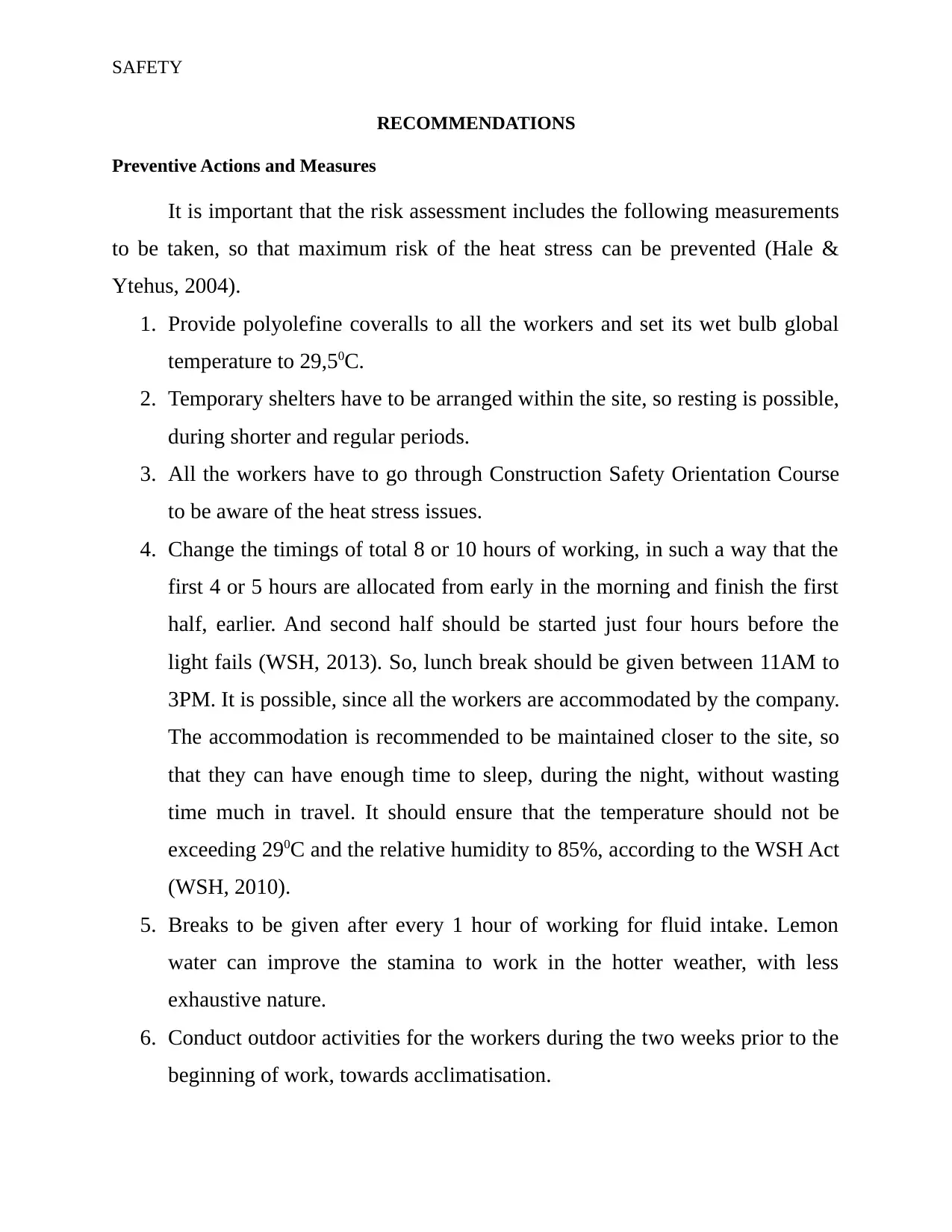
SAFETY
RECOMMENDATIONS
Preventive Actions and Measures
It is important that the risk assessment includes the following measurements
to be taken, so that maximum risk of the heat stress can be prevented (Hale &
Ytehus, 2004).
1. Provide polyolefine coveralls to all the workers and set its wet bulb global
temperature to 29,50C.
2. Temporary shelters have to be arranged within the site, so resting is possible,
during shorter and regular periods.
3. All the workers have to go through Construction Safety Orientation Course
to be aware of the heat stress issues.
4. Change the timings of total 8 or 10 hours of working, in such a way that the
first 4 or 5 hours are allocated from early in the morning and finish the first
half, earlier. And second half should be started just four hours before the
light fails (WSH, 2013). So, lunch break should be given between 11AM to
3PM. It is possible, since all the workers are accommodated by the company.
The accommodation is recommended to be maintained closer to the site, so
that they can have enough time to sleep, during the night, without wasting
time much in travel. It should ensure that the temperature should not be
exceeding 290C and the relative humidity to 85%, according to the WSH Act
(WSH, 2010).
5. Breaks to be given after every 1 hour of working for fluid intake. Lemon
water can improve the stamina to work in the hotter weather, with less
exhaustive nature.
6. Conduct outdoor activities for the workers during the two weeks prior to the
beginning of work, towards acclimatisation.
RECOMMENDATIONS
Preventive Actions and Measures
It is important that the risk assessment includes the following measurements
to be taken, so that maximum risk of the heat stress can be prevented (Hale &
Ytehus, 2004).
1. Provide polyolefine coveralls to all the workers and set its wet bulb global
temperature to 29,50C.
2. Temporary shelters have to be arranged within the site, so resting is possible,
during shorter and regular periods.
3. All the workers have to go through Construction Safety Orientation Course
to be aware of the heat stress issues.
4. Change the timings of total 8 or 10 hours of working, in such a way that the
first 4 or 5 hours are allocated from early in the morning and finish the first
half, earlier. And second half should be started just four hours before the
light fails (WSH, 2013). So, lunch break should be given between 11AM to
3PM. It is possible, since all the workers are accommodated by the company.
The accommodation is recommended to be maintained closer to the site, so
that they can have enough time to sleep, during the night, without wasting
time much in travel. It should ensure that the temperature should not be
exceeding 290C and the relative humidity to 85%, according to the WSH Act
(WSH, 2010).
5. Breaks to be given after every 1 hour of working for fluid intake. Lemon
water can improve the stamina to work in the hotter weather, with less
exhaustive nature.
6. Conduct outdoor activities for the workers during the two weeks prior to the
beginning of work, towards acclimatisation.
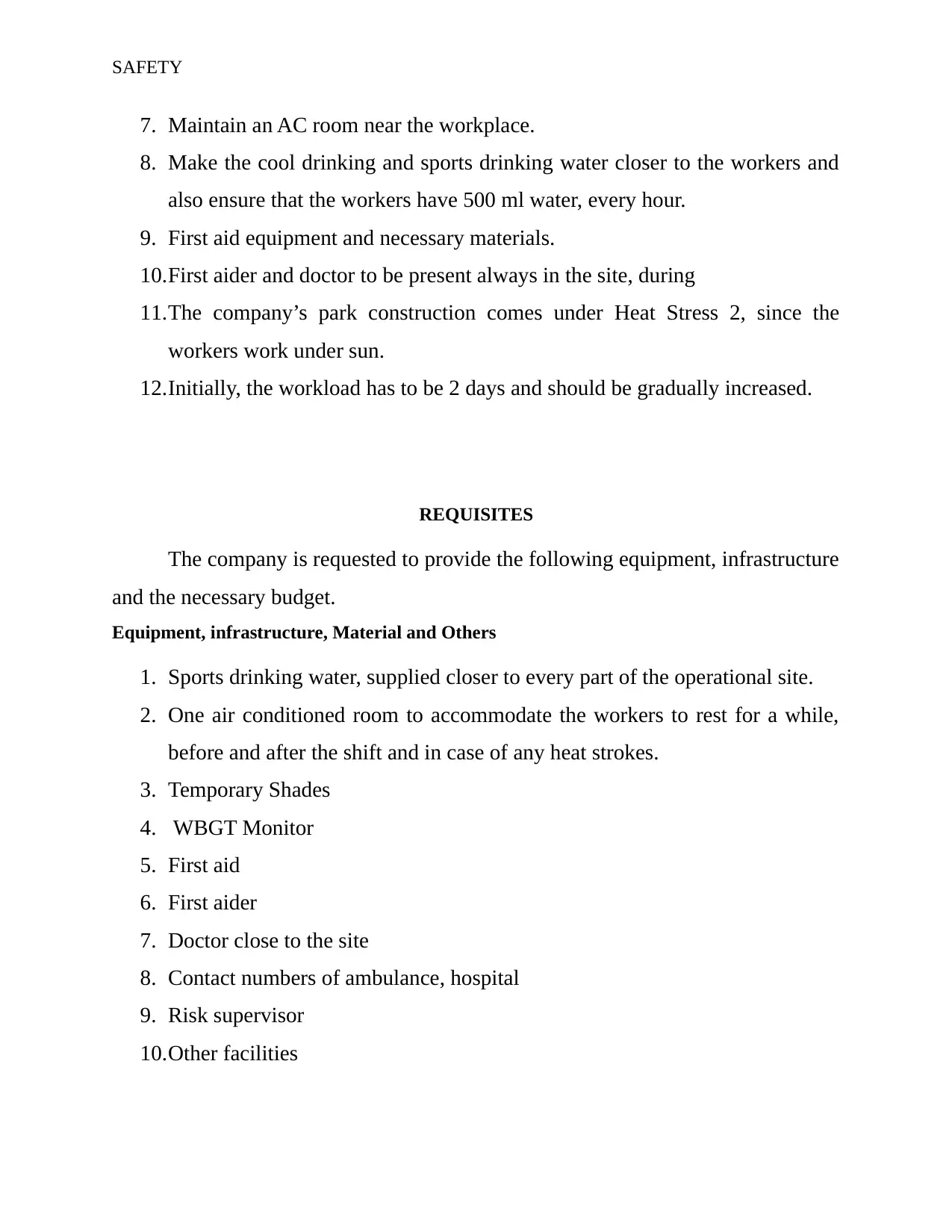
SAFETY
7. Maintain an AC room near the workplace.
8. Make the cool drinking and sports drinking water closer to the workers and
also ensure that the workers have 500 ml water, every hour.
9. First aid equipment and necessary materials.
10.First aider and doctor to be present always in the site, during
11.The company’s park construction comes under Heat Stress 2, since the
workers work under sun.
12.Initially, the workload has to be 2 days and should be gradually increased.
REQUISITES
The company is requested to provide the following equipment, infrastructure
and the necessary budget.
Equipment, infrastructure, Material and Others
1. Sports drinking water, supplied closer to every part of the operational site.
2. One air conditioned room to accommodate the workers to rest for a while,
before and after the shift and in case of any heat strokes.
3. Temporary Shades
4. WBGT Monitor
5. First aid
6. First aider
7. Doctor close to the site
8. Contact numbers of ambulance, hospital
9. Risk supervisor
10.Other facilities
7. Maintain an AC room near the workplace.
8. Make the cool drinking and sports drinking water closer to the workers and
also ensure that the workers have 500 ml water, every hour.
9. First aid equipment and necessary materials.
10.First aider and doctor to be present always in the site, during
11.The company’s park construction comes under Heat Stress 2, since the
workers work under sun.
12.Initially, the workload has to be 2 days and should be gradually increased.
REQUISITES
The company is requested to provide the following equipment, infrastructure
and the necessary budget.
Equipment, infrastructure, Material and Others
1. Sports drinking water, supplied closer to every part of the operational site.
2. One air conditioned room to accommodate the workers to rest for a while,
before and after the shift and in case of any heat strokes.
3. Temporary Shades
4. WBGT Monitor
5. First aid
6. First aider
7. Doctor close to the site
8. Contact numbers of ambulance, hospital
9. Risk supervisor
10.Other facilities
⊘ This is a preview!⊘
Do you want full access?
Subscribe today to unlock all pages.

Trusted by 1+ million students worldwide
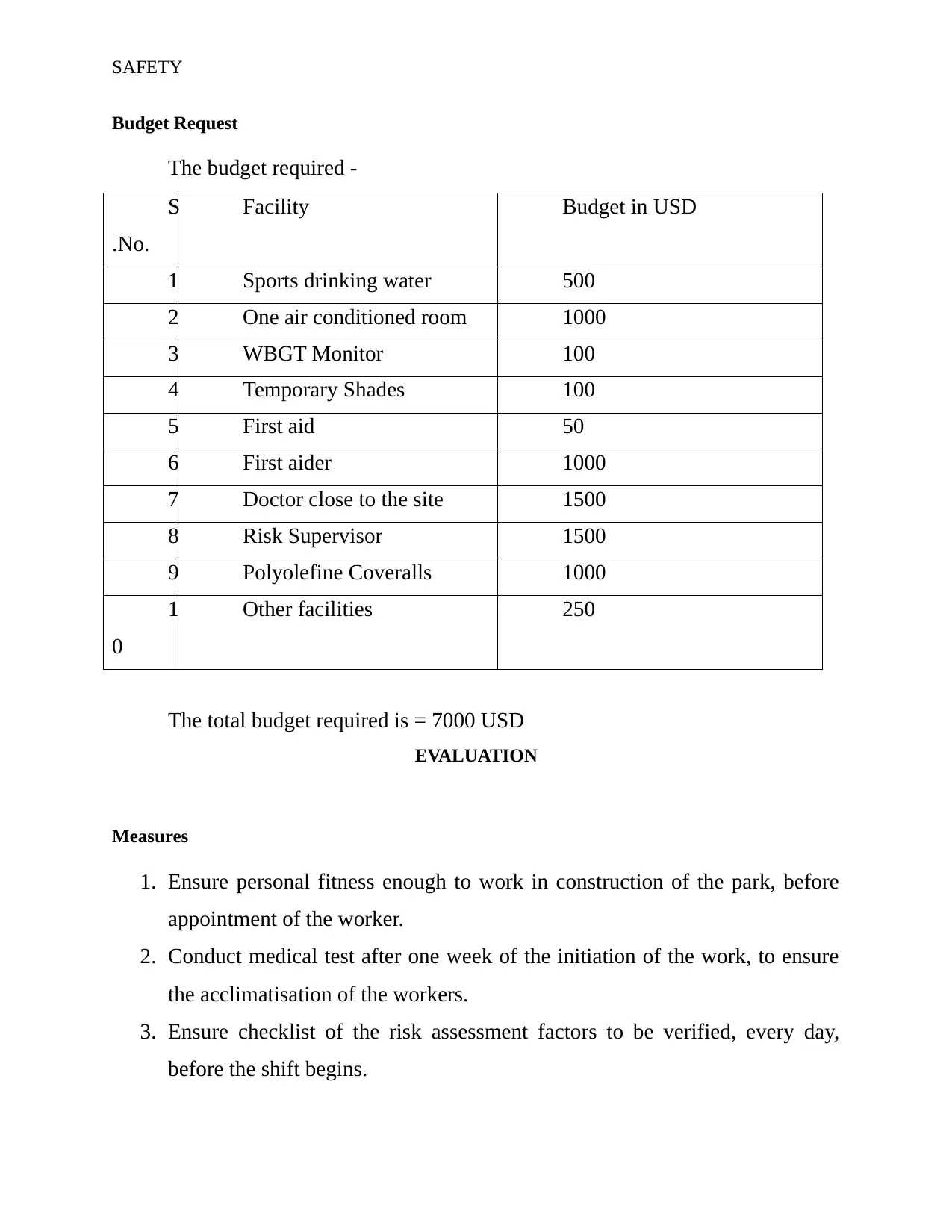
SAFETY
Budget Request
The budget required -
S
.No.
Facility Budget in USD
1 Sports drinking water 500
2 One air conditioned room 1000
3 WBGT Monitor 100
4 Temporary Shades 100
5 First aid 50
6 First aider 1000
7 Doctor close to the site 1500
8 Risk Supervisor 1500
9 Polyolefine Coveralls 1000
1
0
Other facilities 250
The total budget required is = 7000 USD
EVALUATION
Measures
1. Ensure personal fitness enough to work in construction of the park, before
appointment of the worker.
2. Conduct medical test after one week of the initiation of the work, to ensure
the acclimatisation of the workers.
3. Ensure checklist of the risk assessment factors to be verified, every day,
before the shift begins.
Budget Request
The budget required -
S
.No.
Facility Budget in USD
1 Sports drinking water 500
2 One air conditioned room 1000
3 WBGT Monitor 100
4 Temporary Shades 100
5 First aid 50
6 First aider 1000
7 Doctor close to the site 1500
8 Risk Supervisor 1500
9 Polyolefine Coveralls 1000
1
0
Other facilities 250
The total budget required is = 7000 USD
EVALUATION
Measures
1. Ensure personal fitness enough to work in construction of the park, before
appointment of the worker.
2. Conduct medical test after one week of the initiation of the work, to ensure
the acclimatisation of the workers.
3. Ensure checklist of the risk assessment factors to be verified, every day,
before the shift begins.
Paraphrase This Document
Need a fresh take? Get an instant paraphrase of this document with our AI Paraphraser

SAFETY
Report to Company
The parking construction project is carried in the open sun, with no shade
and so the risk assessment, risk factors and recommendations, along with the
budget are provided in the report. It is requested to provide the recommended
facilities, according to the WSH Act.
CONCLUSION
Risk assessment has been performed after a detailed exploration of heat
stress, its causes, factors and treatments. Risk assessment is performed to prevent
the accidents and hazards and the recommendations are provided in the report.
REFERENCES
1. WSH Council, 2010, “Workplace Safety and Health Guidelines: Managing
Heat Stress in the Workplace”, Workplace Safety and Health Council.
2. WSH Council, 2012, “Code of Practice on Workplace Safety and Health –
Risk Management” Workplace Safety and Health Council.
3. WSH Council, 2013, “Workplace Safety and Health Guidelines – Statutory
Medical Examination” Workplace Safety and Health Council.
4. WSH Council, 2008, “Workplace Safety and Health Guidelines –
Healthcare” Workplace Safety and Health Council.
5. WSHC, 2008, “Workplace Safety and Health Guidelines - Hotels, Food and
Beverage”, Workplace Safety and Health Council.
6. 2006, Occupational Safety and Health Management System,
7. Fanning, F. E., 2003, “Basic Safety Administration” A Handbook for the
New Safety Specialist, American Society of Safety Engineers, Chicago
Report to Company
The parking construction project is carried in the open sun, with no shade
and so the risk assessment, risk factors and recommendations, along with the
budget are provided in the report. It is requested to provide the recommended
facilities, according to the WSH Act.
CONCLUSION
Risk assessment has been performed after a detailed exploration of heat
stress, its causes, factors and treatments. Risk assessment is performed to prevent
the accidents and hazards and the recommendations are provided in the report.
REFERENCES
1. WSH Council, 2010, “Workplace Safety and Health Guidelines: Managing
Heat Stress in the Workplace”, Workplace Safety and Health Council.
2. WSH Council, 2012, “Code of Practice on Workplace Safety and Health –
Risk Management” Workplace Safety and Health Council.
3. WSH Council, 2013, “Workplace Safety and Health Guidelines – Statutory
Medical Examination” Workplace Safety and Health Council.
4. WSH Council, 2008, “Workplace Safety and Health Guidelines –
Healthcare” Workplace Safety and Health Council.
5. WSHC, 2008, “Workplace Safety and Health Guidelines - Hotels, Food and
Beverage”, Workplace Safety and Health Council.
6. 2006, Occupational Safety and Health Management System,
7. Fanning, F. E., 2003, “Basic Safety Administration” A Handbook for the
New Safety Specialist, American Society of Safety Engineers, Chicago
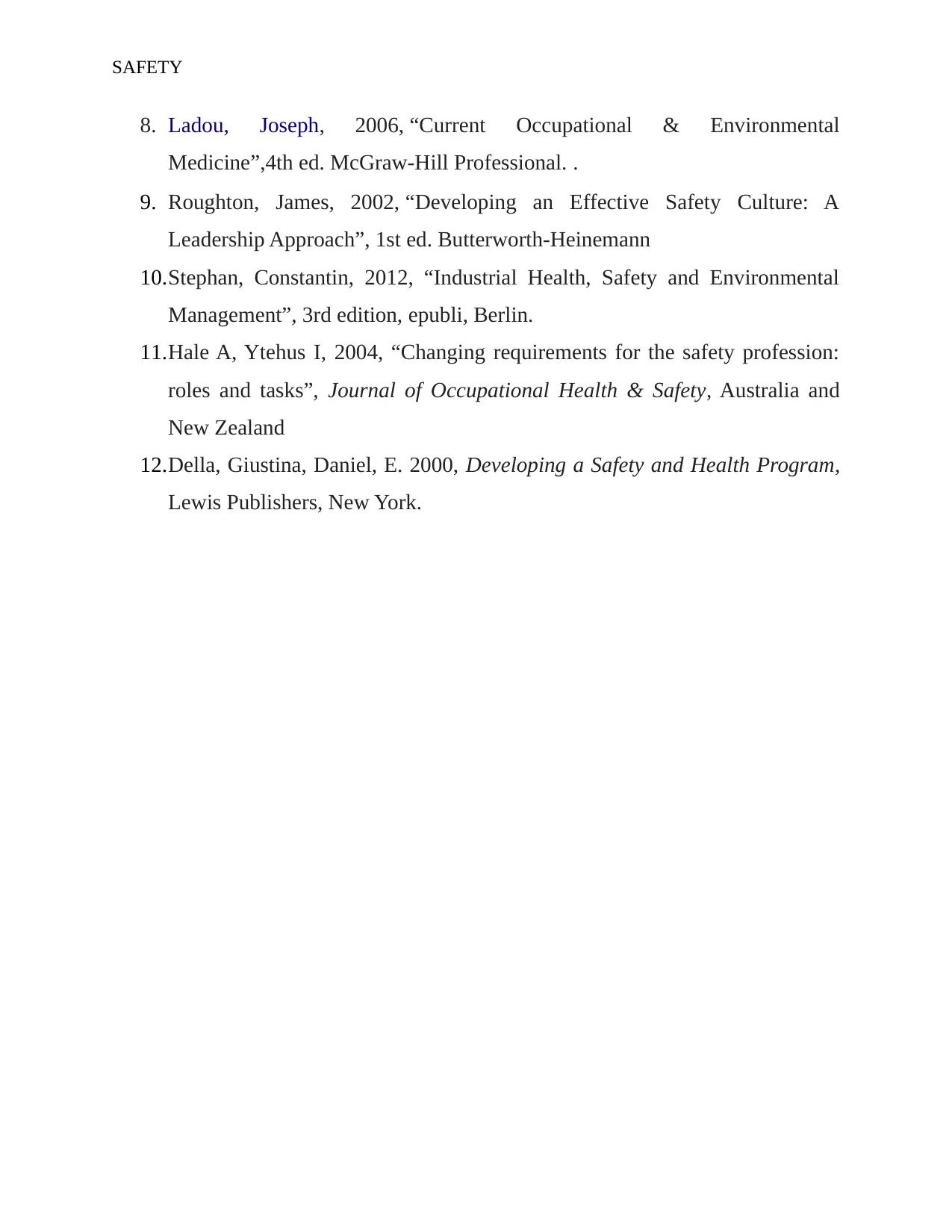
SAFETY
8. Ladou, Joseph, 2006, “Current Occupational & Environmental
Medicine”,4th ed. McGraw-Hill Professional. .
9. Roughton, James, 2002, “Developing an Effective Safety Culture: A
Leadership Approach”, 1st ed. Butterworth-Heinemann
10.Stephan, Constantin, 2012, “Industrial Health, Safety and Environmental
Management”, 3rd edition, epubli, Berlin.
11.Hale A, Ytehus I, 2004, “Changing requirements for the safety profession:
roles and tasks”, Journal of Occupational Health & Safety, Australia and
New Zealand
12.Della, Giustina, Daniel, E. 2000, Developing a Safety and Health Program,
Lewis Publishers, New York.
8. Ladou, Joseph, 2006, “Current Occupational & Environmental
Medicine”,4th ed. McGraw-Hill Professional. .
9. Roughton, James, 2002, “Developing an Effective Safety Culture: A
Leadership Approach”, 1st ed. Butterworth-Heinemann
10.Stephan, Constantin, 2012, “Industrial Health, Safety and Environmental
Management”, 3rd edition, epubli, Berlin.
11.Hale A, Ytehus I, 2004, “Changing requirements for the safety profession:
roles and tasks”, Journal of Occupational Health & Safety, Australia and
New Zealand
12.Della, Giustina, Daniel, E. 2000, Developing a Safety and Health Program,
Lewis Publishers, New York.
⊘ This is a preview!⊘
Do you want full access?
Subscribe today to unlock all pages.

Trusted by 1+ million students worldwide
1 out of 12
Your All-in-One AI-Powered Toolkit for Academic Success.
+13062052269
info@desklib.com
Available 24*7 on WhatsApp / Email
![[object Object]](/_next/static/media/star-bottom.7253800d.svg)
Unlock your academic potential
Copyright © 2020–2025 A2Z Services. All Rights Reserved. Developed and managed by ZUCOL.


